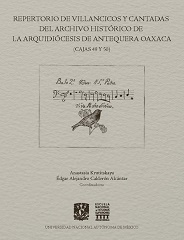New Catalog of the Archivo Histórico de la Arquidiócesis de Antequera Oaxaca (Mexico)
Edgar Alejandro Calderón Alcántar
Monday, February 11, 2019


We have received the following from Edgar Alejandro Calderón Alcántar (Conservatorio de las Rosas) and Anastasia Krutitskaya (ENES, UNAM), Morelia, Mexico:
Anastasia Krutitskaya and Edgar Alejandro Calderón Alcántar. Repertorio de villancicos y cantadas del Archivo Histórico de la Arquidiócesis de Antedquera Oaxaca (cajas 49 y 50). Mexico City: Universidad Nacional Autónoma de México, 2018. Available online.
Repertorio de villancicos y cantadas del Archivo Histórico de la Arquidiócesis de Antequera Oaxaca (boxes 49 and 50) comprises an initial corpus of 39 works, using international criteria of musical cataloging applied by Répertoire International des Sources Musicales (RISM). The music manuscripts date mostly from the 18th century and are conserved in the Historical Archive of the Archdiocese of Antequera Oaxaca (RISM siglum: MEX-Oc).
The Villancicos and Religious Cantatas from New Spain developed a great variety of poetic resources, structures and musical procedures. In these compositions polychoral techniques are reproduced with basso continuo, typical of the aesthetics of the 17th century, but there are also some for a few voices with concerted instruments (violin, viola, etc.) and basso continuo, more typical of the 18th century. An important aspect of this catalog is the interdisciplinary approach between philology and musicology; for that reason, all the records offer a musical incipit corresponding to each vocal and instrumental part and to each section. Literary concordances with other archives, libraries and printed items are included too.
Regarding the composers, the corpus contains four works by Antonio de Salazar (*1650c–†1715), maestro de capilla of the Mexico City Cathedral between 1688 and 1715; 25 compositions by Manuel de Sumaya (*1678–†1755), maestro de capilla of the Mexico City Cathedral from 1715 to 1738 and the Oaxaca Cathedral from 1738 until his death. Everything indicates that Sumaya’s repertoire preserved in the Historical Archive of the Archdiocese of Antequera Oaxaca, before being moved to Oaxaca, was premiered in Mexico City. It is also very probable that Sumaya had displaced the music materials of Antonio de Salazar. In addition, five works by Francisco Martínez de la Costa (*1739–†1769c) appear among the cataloged compositions (Martínez de la Costa served as maestro de capilla of Oaxaca Cathedral from 1766 to 1768 and three other works are attributed to him); plus a villancico by Juan Matías de los Reyes (*1724–†1779), probably a disciple of Manuel de Sumaya; and an anonymous work.
Francisco Martínez de la Costa, Aria a Duo Con Violines
Juan Matías de los Reyes, Cantada
Antonio de Salazar, Escuchen, escuchen
Manuel de Sumaya, Corrientes que al mar
Sumaya, Recitado
Images at top: Sumaya, Pedro es el maestro and cover to the new catalog. All images courtesy of Anastasia Krutitskaya.
Share Tweet EmailCategory: New publications

